I hugely enjoy my work as a sea kayak instructor, but since I’m only certified to teach up to Paddle Canada’s Sea Kayaking Level 1 on my own, I usually just get to paddle locally in the Iy̓ál̓mexw/Ayyulshun (Jericho Beach/English Bay) area with my students. So when the opportunity arose to assistant-instruct on a Paddle Canada Level 2 Sea Kayaking course, with three days and two nights away in Átl’ka7tsem/Txwnéwu7ts (Howe Sound), I was in faster than you can say “re-entry roll”!
Sweetening the pot was the fact that my friend and colleague, Mike McHolm, would be the lead instructor on the course. I’ve known Mike since he was a customer at the late, lamented Ecomarine. Mike absolutely caught fire as a kayaker, and recently earned his Paddle Canada Sea Kayaking Level 4 (for those not in the know, that’s about one step below being able to calm the seas and walk on the water.)
Mike and I have co-instructed on Paddle Canada Beginner Sea Kayaking and Intermediate (Level 1) courses before, and found we have nicely complementary skill sets: he’s the master of advanced strokes, braces, scrambles and rolls; I’ve got a solid background of practical experience with extended touring and navigation.
The prep for the trip portion of the course included two intense days of on-water and on-shore instruction at Jericho Beach over the September 16-17 weekend. As it happened, three of the six students in this Level 2 course were graduates of a Paddle Canada Level 1 course I’d taught the weekend before.
September 29, 2023
A bit after 8AM, Mike and I rolled into Xwawchayay (Porteau Cove) in the Yakmobile (a Yukon truck with a custom-made roof rack that can accommodate up to ten kayaks). As we offloaded the boats, our students joined us. The usual knocked-over-anthill scurrying about ensued, as we all packed our kayaks for the first time on this trip. Next, we had a pre-launch meeting, where we went over “Me, We, and The Sea”, reviewed some compass navigation and dead reckoning techniques, confirmed our planned route, and designated lead and sweep paddlers.
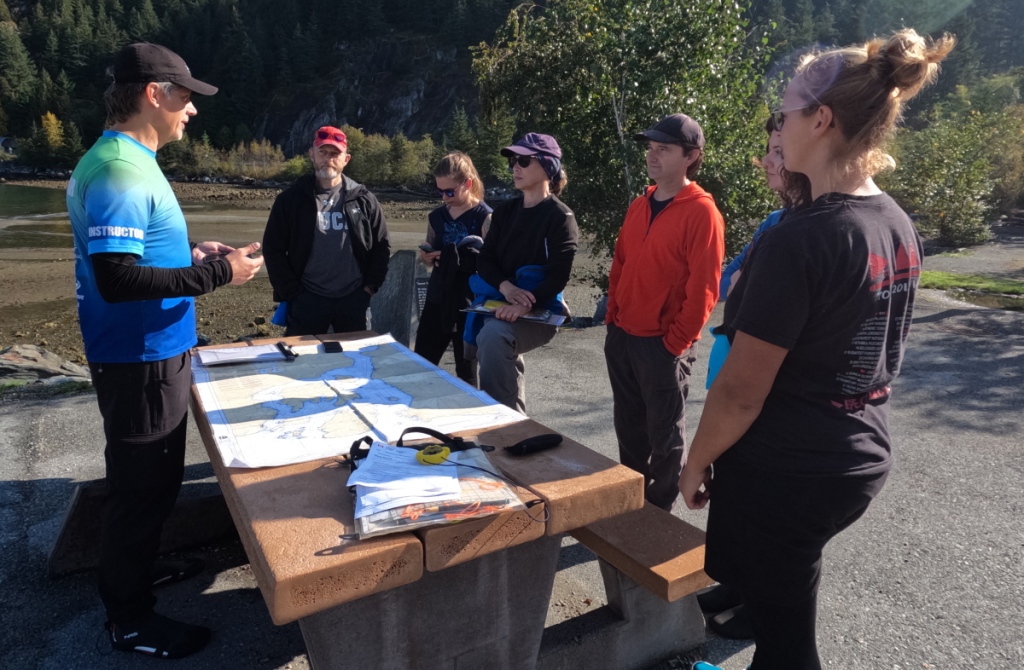
We launched around 12:15PM onto calm and sunny seas, course set for the Defence Islands. About 45 minutes later we hit the gap between them, pretty much bang on our time-distance-speed prediction.
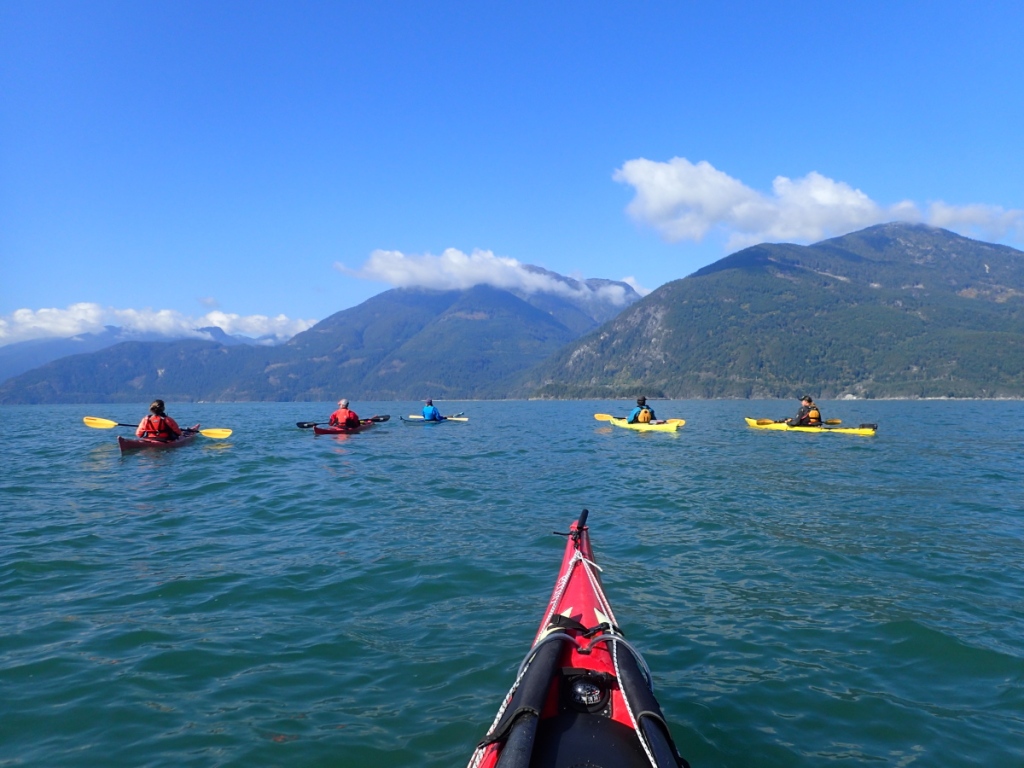
From there, we handrailed along the shoreline to Ts’itpsm (Zorro Bay), practicing our bow and stern rudders as we went. The slight inflow wind that had picked up nudged us gently on our way.
Our class included many with prior sea kayaking experience, including Chessy, who’s previously paddled with Mike in some serious seas. She entertained us (and cooled herself off) by nonchalantly popping off both paddle and hand rolls enroute.

We arrived at Zorro Bay to find, amazingly for a long weekend with such nice weather, that we had it all to ourselves. Some of us doubled up our tents on the pads sites to leave at least one platform open for possible later arrivals.

At about 15:30, we relaunched into the bay to work on bow and stern rudders and hanging draws. The shallow waters of the bay were turquoise, which combined with the sunshine to create an almost tropical vibe.
Actually performing a roll is not a requirement to pass Sea Kayaking Level 2: you’ve just got to be able to demonstrate you understand the theory. But Mike had led a rolling session during our pre-trip prep weekend, and some students had really gotten into it, among them Leah. Spotted by Chessy (she who had demonstrated hand rolls earlier), Leah pulled off a few paddle rolls herself before coming ashore.
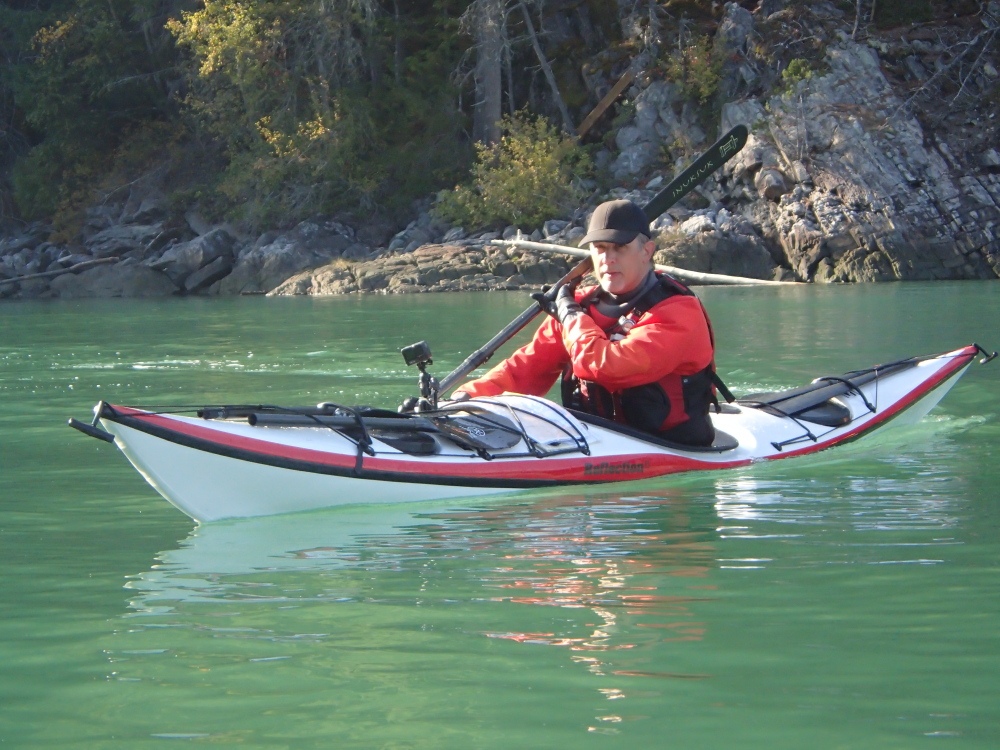

Evening class was on knots and ropework as related to rigging tarps over tents and kitchens. Fortunately, this was all merely theoretical, as the clear skies continued.
With all this learning, we dined European-style late. The main course was a spicy dish of noodles in peanut sauce with stir-fried veggies, including wild-harvested mushrooms courtesy of Claus and Alysia (since none of us started tripping out or tripping over, we can assume they know their ‘shrooms.) For dessert, I heated a deep-dish apple pie in my Outback Oven ‘til it had a convincingly fresh-baked feel, then topped it with real, albeit aerosol-can, whipped cream. (In response to questions from the class, I did acknowledge that I’m not always sure whether I eat in order to kayak tour, or kayak tour in order to eat…)
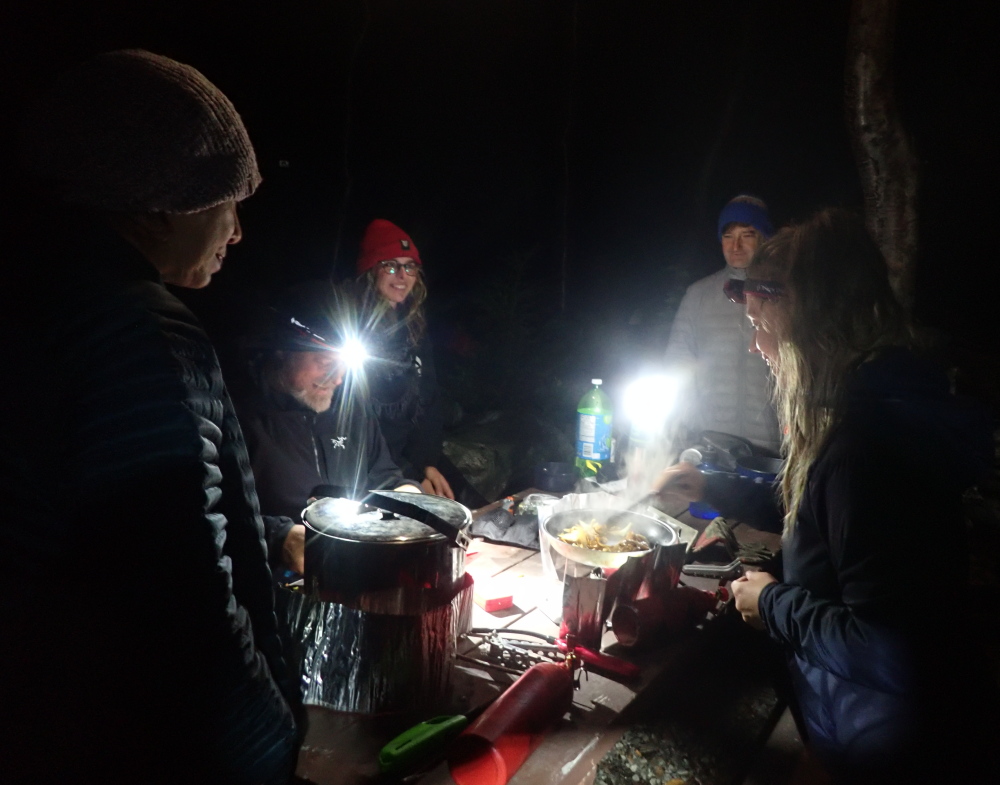
I got to bed about 10PM. Initially it was warm enough that I merely draped my winter-weight down bag over myself duvet-style, but later in the night things cooled down enough that I burrowed into it full mummy-style, and was glad to have the option: crawling out of bed pre-chilled in the morning is not inspiring for a day of challenging paddling.
September 30, 2023
I made my way down to the beach to find warm and sunny conditions, with the water outside the bay windy with whitecaps – perfect Level 2 conditions (it’s a requirement for passing the course that students complete at least some paddling in waves with winds in the 19 knots range.) Tragically, the wind and waves died shortly after we launched at about 10:40. So all the students, who were attempting cowboy scramble re-entries (and reverting to paddlefloat re-entries if they couldn’t pull one off), got to swim in calm water.
It’s worth noting that Level 2 is the point at which instructors begin to stress test students a bit. It’s not stress for the sake of stress: it’s because, as Mike noted during class, overnight trips are getting into life-and-death decision territory, so it’s better to learn lessons from mistakes in practice than “for real”. It was in that spirit that I yanked an insufficiently-secured paddlefloat off the end of one student’s paddle during their re-entry. As I explained to them later on shore: if you think I was being harsh and unforgiving, imagine how harsh and unforgiving one metre seas would be. Fortunately the student understood my point completely, and no hard feelings resulted.
After reviewing the bow and stern rudder and the hanging draw, we handrailed south along the shore towards Lhemlhemḵwús (Islet View) campsite. Enroute, Mike encouraged the students to head at maximum speed straight at a convenient cliff. This was not so much to test the strength of their kayaks; it was more to encourage them to deploy a low or high brace turn effectively!

We landed at Islet View about 12:40. Shortly afterwards, a family arrived in a small RIB stacked high with camping gear and were visibly relieved to discover that the eight of us paddling riff-raff were just there for lunch. As Mike went over the shore lesson (the signs of and responses to hypo and hyperthermia), several of his friends from SKABC paddled in.
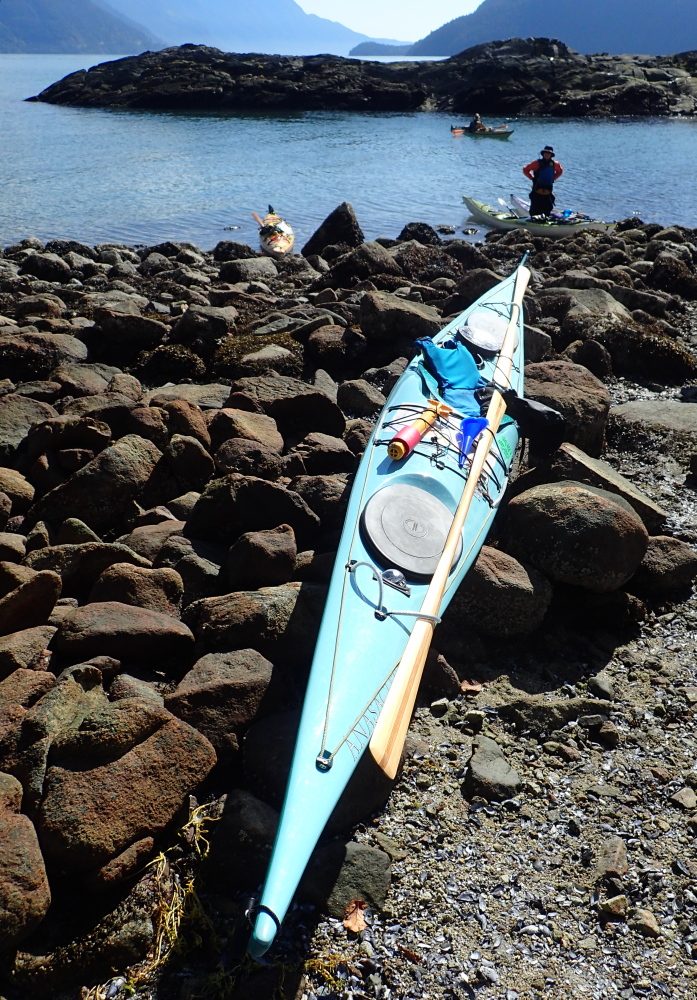
We relaunched about 14:20, and did tows with both throwlines and towlines, working up to towing a victim who needed to be stabilized by being rafted with a second rescuer. This culminated in teams of three – two rescuers, one hypothermic capsize victim – towing a patient back to Zorro Bay, and setting up a rewarming “burrito”.
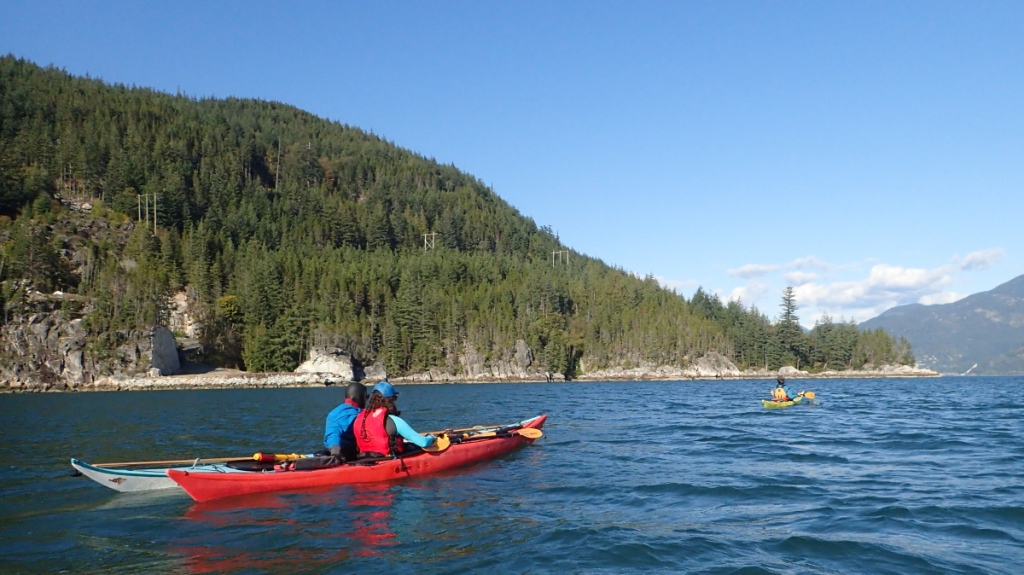
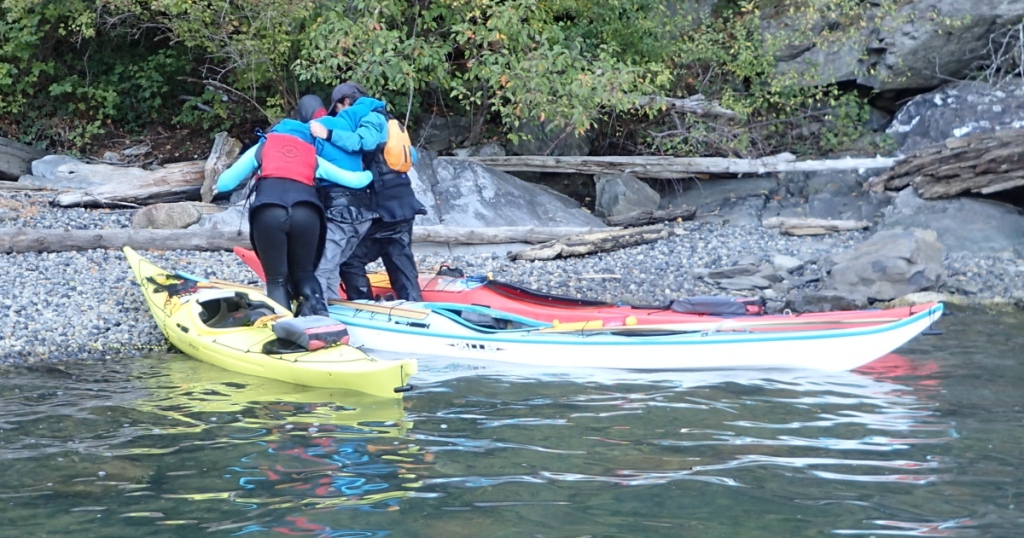
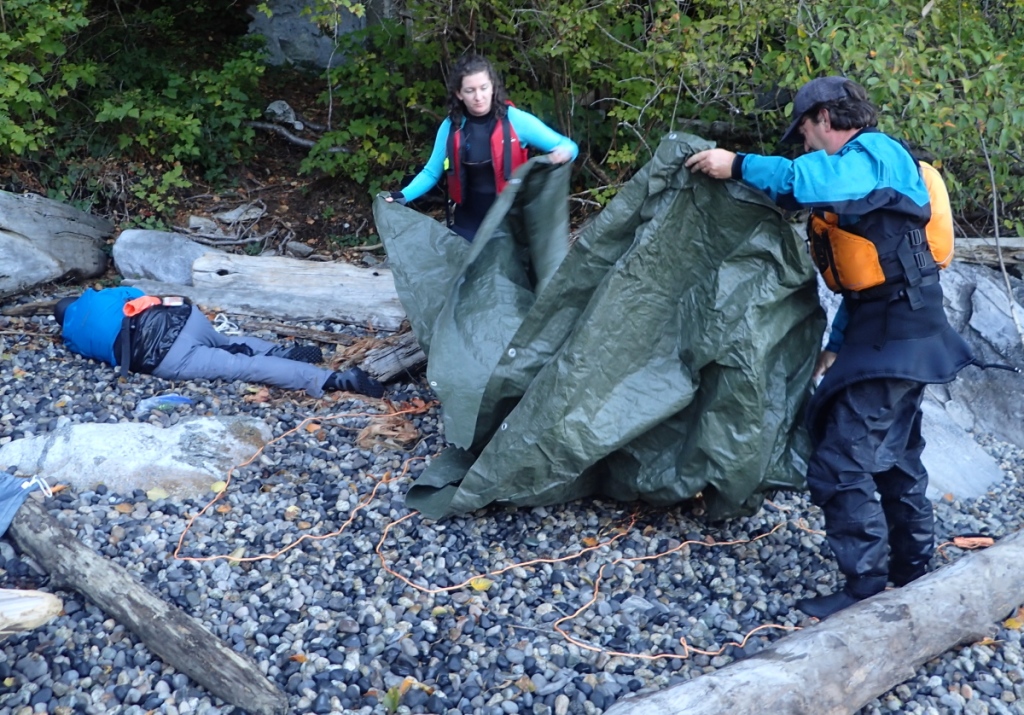
Leah was once again keen to practice her rolls before supper, so I spotted her, occasionally offering my bow for a bow rescue. She returned the favour when I was ready to try a few. Fortunately for my instructor honour, no bow rescue was needed — all my rolls worked, though it has to be said that none of them were pretty or “demonstration quality.” Leah generously proffered the rationale that this was because we’d had a long, tiring day, and I gratefully seized on this pretext like, er, a kayaker who’s repeatedly failed their roll grabbing a friendly bow.
My drysuit insulation layers were mildly damp from a combination of sweat and slight seepage during my rolls. It was too late in the day to sun-dry them, so I used a trick from my days touring on the Northern wet coast: layering them onto the gear loft in my tent, then suspending a lit candle lantern a safe distance below. The gentle heat dries out the moisture and, as a bonus, provides a welcoming beacon for finding your tent after dark.
Drew and Julia were on supper duty, and did not disappoint: an excellent home-made chili with grated cheese, sour cream, bread and all the trimmings. I was once again the dessert chef. Tonight’s course was assorted Auntie’s Puddings. I hadn’t been able to fit the microwave oven recommended for reheating them into my skeg kayak, so I simmered them in hot water for 20 minutes instead. While that was happening I whipped up the instant custard without which no proper English dessert is complete. (I briefly thought I’d made far too much custard, but Leah and Julia actually hoarded the surplus in a water bottle overnight and added it to their breakfasts the next morning in lieu of milk!)
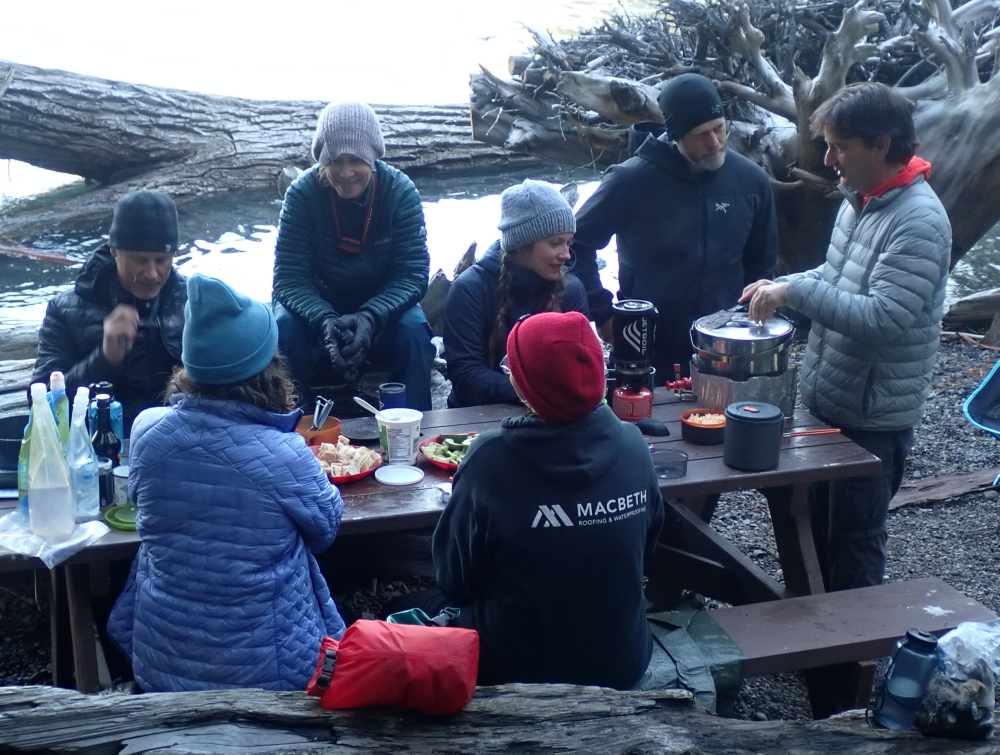
We were not the only mammals who dined well: as a shriek from the direction of the food cache box announced, Mike’s improvised fix to the box’s rusted-out bottom (piled-up gravel and rocks) had failed to keep out the mice. Fortunately, nothing critical was spoiled, and we moved our remaining provisions to the greater safety of the kayaks.
It was a working supper: as we ate, we covered Collision Regulations, Environmental Impact, Tool/Repair Kits and Indigenous Relations and Considerations (the latter especially appropriate as today was the National Day for Truth and Reconciliation, plus we were camped on First Nations Land generously made available as a water-access site.)
October 1, 2023
Determined not to be robbed of rougher conditions again, Mike had us all on the water shortly before 9AM. The sea state was a satisfactory brew of whitecaps and wind.

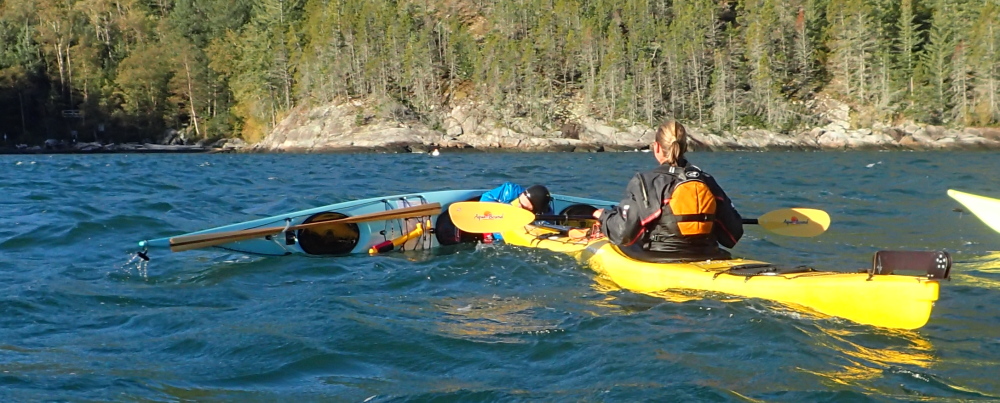

As expected, the class found all their maneuvers, from turns to re-entries, rather more challenging in sporty water. But when you think about it, bouncy seas are exactly the conditions in which you’re more likely to need braces, rolls or re-entries. So best to practice in realistic conditions. Enroute back to shore, the class got to use their stern rudders “for real” to keep their boats from being broached by the following seas.
We packed up camp while eating an early lunch, then launched for Porteau Cove, via a dogleg at Furry Creek. Enroute, Mike and I debriefed several of the students two-on-one.
Once we were just off Porteau Cove, a bit inshore of the buoys marking the sunken ship dive site, we did the final class exercise: an “all in” with everyone wet-exited and helping one another back into their boats.

We landed, took advantage of the outdoor showers meant for the Porteau Cove divers to rinse the salt water off our immersion wear, skirts and PFDs, then packed up, including reloading several kayaks onto the yakmobile — that went a lot faster with a crowd of willing hands than it had on Thursday evening when Mike and I had been doing it ourselves at Jericho Beach Kayak. As we completed all this, we could see rain clouds moving in, proof that our timing had been perfect, weather-wise (and it was wonderful when unpacking at home not to be wrestling with wet and muddy gear).
Mike and I finished debriefing the remaining students, then said our congratulations and farewells. Holiday traffic meant it was fairly late in the day by the time we were back at Jericho Beach Kayak and offloading the boats, so we were both pretty bushed, and much overdue for showers (drysuits keep out the brine but seal in sweat and body odour with equal effectiveness). However, the satisfaction of having worked with a wonderful group of people and helped them towards new adventures kept us energized!
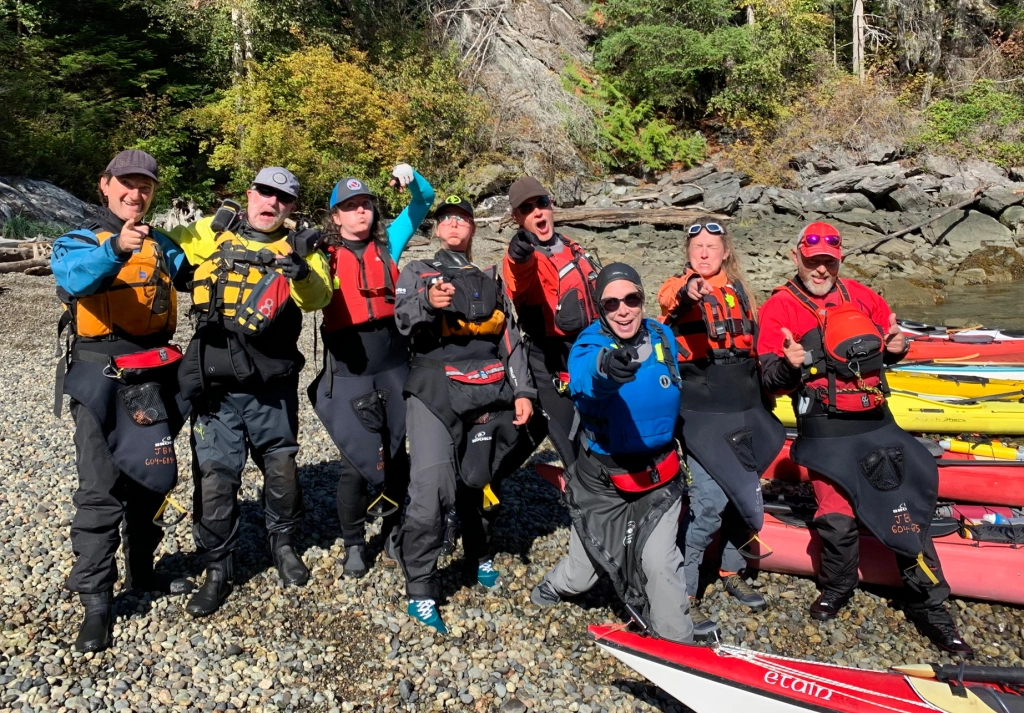
Update: my fellow instructor Mike made a short video about the weekend that will give you a better sense of what dynamic water looks like.
